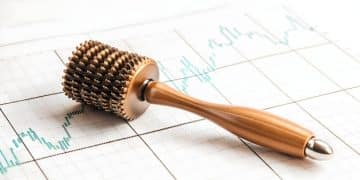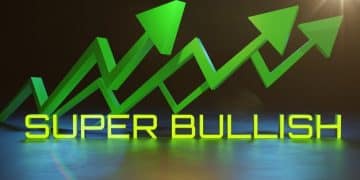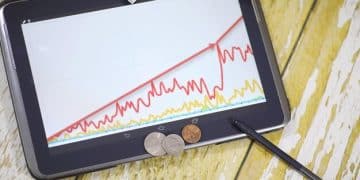Will the Fed Raise Interest Rates Again in Early 2025? Expert Forecasts
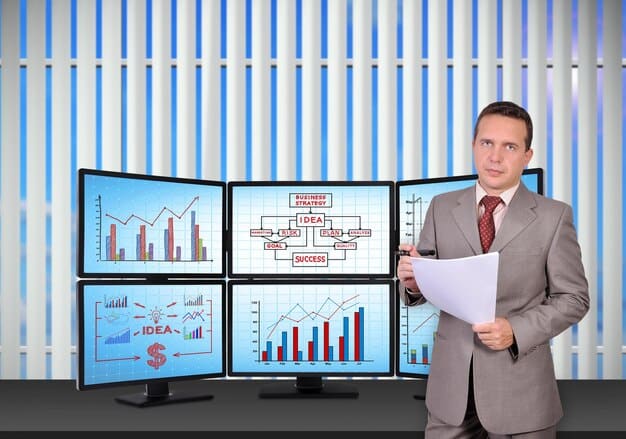
Navigating the complex landscape of monetary policy, the Federal Reserve’s potential decision to raise interest rates again in early 2025 hinges on persistent inflation, labor market dynamics, and global economic stability, requiring close observation of upcoming economic indicators and central bank communications.
The question of whether the Fed will raise interest rates again in early 2025 is a significant one, resonating across financial markets, businesses, and households. Understanding the forces shaping this potential decision requires delving into expert analysis and a nuanced look at economic forecasts. This article explores the current economic climate, the Federal Reserve’s mandate, and the indicators most likely to influence its future policy actions.
Understanding the Federal Reserve’s Mandate and Current Stance
The Federal Reserve, the central bank of the United States, operates under a dual mandate: to foster maximum employment and maintain price stability. These two objectives often require a delicate balancing act, especially in times of economic uncertainty. Historically, the Fed has used interest rate adjustments as a primary tool to achieve these goals, influencing borrowing costs, investment, and ultimately, economic growth and inflation.
Currently, the Fed’s stance reflects a period of vigilant caution. After an aggressive tightening cycle to combat persistent inflation, the central bank has indicated a data-dependent approach. This means that future policy decisions, including any potential rate hikes in early 2025, will be heavily influenced by incoming economic data.
Historical Context: The Fight Against Inflation
The recent history of Fed policy is characterized by its fervent efforts to bring inflation down from multi-decade highs. Starting in 2022, the Federal Open Market Committee (FOMC) implemented a series of rapid and substantial rate increases, driving the federal funds rate to its highest level in over two decades. This aggressive posture was necessary to cool an overheating economy and curb inflationary pressures fueled by supply chain disruptions, strong consumer demand, and geopolitical events.
- 2022 Tightening Cycle: Multiple consecutive rate hikes, increasing the federal funds target range significantly.
- Peak Inflation Response: Direct intervention to reduce aggregate demand and inflationary expectations.
- Impact on Borrowing Costs: Higher interest rates affected mortgages, auto loans, and corporate borrowing.
While these measures have shown signs of success, with inflation gradually receding from its peak, the journey to the Fed’s target of 2% remains ongoing. The central bank remains wary of premature declarations of victory, emphasizing the need for sustained evidence that inflation is firmly on a downward path.
This historical backdrop is crucial for understanding the Fed’s cautious optimism. They are acutely aware of the risks of both tightening too much and too little. The former could trigger an unnecessary recession, while the latter could reignite inflationary pressures, undoing previous progress. Therefore, any decision in early 2025 will be heavily informed by the lessons learned from this recent period of economic volatility.
Key Economic Indicators Influencing Fed Decisions
The Federal Reserve’s policy decisions are not made in a vacuum; they are a direct response to a complex array of economic data. To assess the likelihood of rate hikes in early 2025, it’s essential to understand the primary indicators the FOMC scrutinizes.
Inflationary Pressures: CPI and PCE
The most critical determinant is inflation. The Fed primarily monitors two key inflation metrics: the Consumer Price Index (CPI) and the Personal Consumption Expenditures (PCE) price index. While CPI often receives more media attention, the PCE index, particularly the core PCE (excluding volatile food and energy components), is the Fed’s preferred measure.
If these indices show signs of re-acceleration or demonstrate stubborn persistence above the Fed’s 2% target, it could strongly signal the need for further tightening. Conversely, a consistent deceleration towards the target would reduce the urgency for additional rate hikes. Factors such as global energy prices, geopolitical tensions affecting supply chains, and domestic wage growth all play a role in shaping these inflation figures.
For example, unexpected increases in oil prices or renewed supply chain bottlenecks could put upward pressure on inflation, potentially forcing the Fed’s hand. On the other hand, a continued moderation in housing costs and a rebalancing of goods and services demand would provide comfort to policymakers.
Labor Market Dynamics: Employment and Wages
The state of the labor market is another cornerstone of the Fed’s assessment. A robust labor market, characterized by low unemployment rates and strong wage growth, can be a double-edged sword. While indicative of a healthy economy, it can also contribute to inflationary pressures as businesses pass on higher labor costs to consumers.
- Unemployment Rate: Persistent low unemployment might signal an overheating economy, potentially requiring a rate hike.
- Wage Growth: Elevated wage growth, if consistently outpacing productivity, could fuel services inflation.
- Job Openings: A high number of job openings relative to available workers indicates continued labor market tightness.
The Fed will closely watch monthly jobs reports, including nonfarm payrolls, unemployment rates, and average hourly earnings. A significant softening of the labor market could be interpreted as a sign that previous rate hikes are having their intended effect, suggesting less need for further tightening. Conversely, a resilient labor market, particularly if accompanied by strong wage gains, might lead them to consider another increase.
Economic Growth and Consumer Spending
Beyond inflation and employment, the Fed also considers broader measures of economic activity, such as GDP growth and consumer spending. A surprisingly strong economy, defying expectations of a slowdown, might provide the Fed with room to raise rates further if inflation remains elevated. Consumer spending, which accounts for a significant portion of US economic activity, is particularly impactful.
Retail sales data, consumer confidence surveys, and business investment figures will all be under scrutiny. If consumers continue to spend robustly despite higher borrowing costs, it might suggest that the economy can withstand further tightening. However, signs of significant economic deceleration or recessionary pressures would strongly argue against additional rate hikes, potentially even paving the way for cuts.

Expert Analysis and Diverse Perspectives
Predicting the Federal Reserve’s next move is a task fraught with complexity, leading to a spectrum of expert opinions. Financial analysts, economic forecasters, and central bank watchers often present differing views, each based on their interpretation of available data and their models of economic behavior.
Hawks vs. Doves: A Policy Spectrum
Within the Federal Reserve itself, and among external observers, there exists a philosophical divide often characterized as “hawks” and “doves.”
- Hawks: Prioritize fighting inflation, even if it means slower economic growth or a slightly higher unemployment rate. They are generally more inclined to support rate hikes.
- Doves: Tend to prioritize maximum employment and economic growth, advocating for lower interest rates to stimulate the economy, even if it means tolerating slightly higher inflation for a period. They would be more resistant to further rate increases.
This internal debate within the FOMC significantly influences the final policy decisions. Market participants closely analyze public statements from various Fed officials, trying to discern the prevailing sentiment and potential shifts in policy direction.
Consensus Forecasts and Leading Institutions
While no single prediction is guaranteed, a consensus often emerges from major financial institutions, investment banks, and academic economists. These consensus forecasts are typically compiled by surveying a broad range of experts. For instance, reports from institutions like Goldman Sachs, JPMorgan Chase, and the International Monetary Fund (IMF) offer valuable insights.
A recent survey of economists might show a split view: perhaps a slight majority forecasting a pause, but a significant minority still expecting an additional hike if inflation proves sticky. These forecasts are dynamic, constantly adjusting as new economic data becomes available, making it crucial to follow updated reports.
For early 2025, many experts anticipate the Fed will remain highly data-dependent. Some argue that without a clear resurgence in inflation, the current rate levels might be sufficiently restrictive. Others point to potential risks like geopolitical instability or a renewed supply shock as reasons why the Fed might be forced to act again. The current baseline scenario for many is a prolonged period of holding rates steady, but with the option to hike if conditions warrant.
Potential Scenarios for Early 2025
As we look towards early 2025, several distinct economic scenarios could unfold, each with different implications for the Fed’s interest rate policy. Understanding these potential paths is crucial for businesses and individuals planning for the future.
Scenario 1: Persistent Inflation Requires Further Tightening
In this scenario, inflation, while having cooled from its peaks, proves to be stickier than anticipated. This could be due to several factors:
- Robust Wage Growth: Continued strong wage increases, particularly in the services sector, could force businesses to raise prices.
- Renewed Supply Shocks: Unforeseen global events, such as new geopolitical conflicts or natural disasters, could disrupt supply chains and push up commodity prices.
- Strong Consumer Demand: If consumer spending remains unexpectedly resilient, fueled perhaps by excess savings or a strong labor market, it could keep demand-side inflationary pressures alive.
Under these conditions, the Fed would likely feel compelled to resume rate hikes, even if it risks slowing economic growth further. Their primary mandate to achieve price stability would take precedence, leading to another 25 or 50 basis point increase in early 2025.
Scenario 2: Inflation Moderates, Economy Slows – Rates Hold Steady (or Cut)
This scenario envisions a more benign outcome, where inflation continues its downward trend, gradually approaching the Fed’s 2% target. Simultaneously, the economy experiences a “soft landing” – growth decelerates, but a full-blown recession is avoided. Key indicators for this path would include:
- Declining Core PCE: Consistent monthly declines in core PCE, indicating broad disinflation.
- Balanced Labor Market: The unemployment rate rises modestly, and wage growth normalizes without excessive job losses.
- Moderate Consumer Spending: Consumers trim discretionary spending, easing demand pressures.
In this case, the Fed would likely maintain its current policy rate, allowing the lagged effects of past hikes to continue working through the economy. There’s even a possibility, especially if economic growth slows significantly or if a strong disinflationary trend emerges, that the Fed might begin to signal or even implement a rate cut towards the latter half of 2025, rather than a hike.
Scenario 3: Unexpected Economic Shock or Recession
This is the most pessimistic scenario, where an unforeseen shock hits the economy, or the cumulative effect of past rate hikes tips the economy into a recession. Such a shock could be:
- Financial Instability: A major banking crisis or significant market turmoil.
- Global Economic Downturn: A severe recession among major trading partners impacting US exports.
- Domestic Demand Collapse: A sharp fall in consumer confidence and spending, leading to widespread layoffs.
In this situation, the Fed would almost certainly pivot from any consideration of rate hikes to implementing accommodative monetary policy, including rate cuts, to support the economy and prevent a deeper downturn. The focus would shift entirely from fighting inflation to preventing deflation and unemployment.
Each of these scenarios highlights the profound uncertainty facing policymakers. The Fed’s decisions in early 2025 will be a reaction to the specific economic data and global context prevalent at that time, demanding flexibility and a data-driven approach.
The Role of Global Economic Factors
While the Federal Reserve’s primary focus is the US economy, global economic conditions are never far from its considerations. Interconnectedness means that international developments can significantly influence domestic inflation, growth, and financial stability, thereby impacting Fed policy in early 2025.
One major factor is the state of the global supply chains. Periods of robust global growth generally support higher demand, which can lead to inflationary pressures. Conversely, a slowdown in major economies, particularly in China or Europe, could dampen global demand and ease price pressures on internationally traded goods. The Fed pays close attention to global manufacturing data and shipping costs as indicators of potential supply-side shocks or relief.
Geopolitical Events and Commodity Prices
Geopolitical tensions, such as ongoing conflicts or trade disputes, can have an outsized impact on commodity markets, especially oil and natural gas. Spikes in energy prices, for example, directly feed into inflation through transportation costs and utility bills, affecting both consumers and businesses. A significant increase in commodity prices could force the Fed to consider further tightening, even if domestic demand appears to be cooling.
The stability of global financial markets is another critical consideration. A financial crisis in another major economy, or widespread market turbulence, could spill over into the US, affecting investor confidence and capital flows. The Fed might react to such events by pausing or even reversing tightening plans to ensure financial stability.
Exchange Rates and US Exports/Imports
The strength of the US dollar, influenced by interest rate differentials between the US and other major economies, also plays a role. A strong dollar can make US exports more expensive and imports cheaper, potentially exerting downward pressure on domestic inflation. Conversely, a weakening dollar could contribute to imported inflation.
While not a primary driver, the Fed monitors exchange rate movements for their indirect effects on trade balances and price stability. Therefore, the actions of other major central banks, such as the European Central Bank (ECB) or the Bank of England, are also loosely watched, as their policy decisions can affect global capital flows and the relative value of currencies.
Long-Term Implications of Interest Rate Policy
Beyond the immediate economic impact, the Federal Reserve’s interest rate decisions carry significant long-term implications for various sectors of the economy, shaping investment, savings, and the overall financial landscape well into 2025 and beyond.
Impact on Debt and Investment
Higher interest rates, whether they are maintained or increased further, raise the cost of borrowing for both businesses and consumers. This can cool down investment in new projects, expand existing operations, or purchase big-ticket items like homes and cars. Companies might delay expansion plans, reducing job creation and potentially slowing economic growth in the long run.
- Mortgage Rates: Higher rates mean less affordable housing, impacting homeownership and real estate markets.
- Corporate Bonds: Increased borrowing costs for corporations, potentially leading to reduced capital expenditure.
- Government Debt: The cost of servicing the national debt rises, potentially impacting fiscal policy and government spending priorities.
Conversely, very low interest rates, while stimulating growth, can also lead to misallocation of capital and asset bubbles. The Fed aims for a neutral rate that supports sustainable growth without fostering excessive risk-taking.
Savings and Retirement
For savers, higher interest rates offer a silver lining. Returns on savings accounts, certificates of deposit (CDs), and money market funds improve, providing a boost to individuals relying on fixed-income investments. This is particularly beneficial for retirees and those with conservative investment strategies.
However, the impact on retirement planning is complex. While bonds yield more, higher rates can also put pressure on equity markets, especially for growth stocks, as future earnings are discounted at a higher rate. Individuals need to adjust their investment strategies to account for an environment where the “risk-free” rate of return is no longer near zero.
Inflation Expectations and Trust in the Fed
Perhaps one of the most critical long-term implications is the Fed’s ability to anchor inflation expectations. If individuals and businesses believe that inflation will remain high, they will adjust their behavior accordingly – demanding higher wages, raising prices, and embedding inflation into their decision-making. This can create a self-fulfilling prophecy, making inflation much harder to tame.
The Fed’s credibility hinges on its ability to demonstrate a commitment to its 2% inflation target. A perceived failure to control inflation could erode public trust, making future monetary policy interventions less effective. Therefore, any decision in early 2025 will not only be about immediate economic data but also about reinforcing the market’s long-term belief in the Fed’s resolve and capacity to achieve price stability.
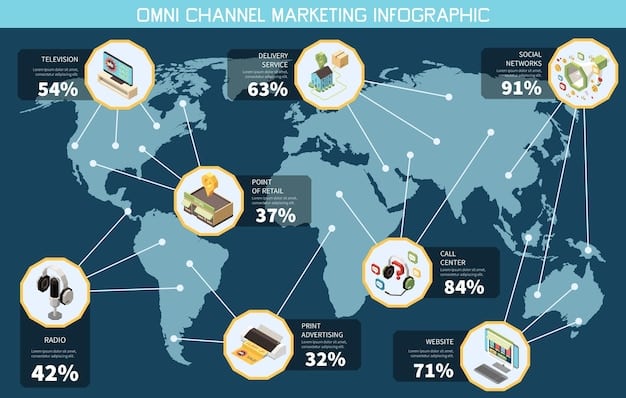
Forecasting the Unpredictable: Challenges and Nuances
Forecasting the future of interest rates, particularly movements from a complex institution like the Federal Reserve, is inherently challenging. Despite sophisticated models and expert analysis, economic predictions are subject to numerous variables and unforeseen events. This section explores some of the key challenges and nuances in forecasting Fed policy for early 2025.
Data Lag and Revisions
One primary challenge is that economic data often has a lag. The inflation and employment figures we receive today reflect conditions from weeks or even months ago. Furthermore, initial data releases are frequently revised, sometimes significantly, affecting the retrospective understanding of economic trends. This means the Fed is often making decisions based on an incomplete and evolving picture of the economy, akin to “driving by looking in the rearview mirror.”
For example, a strong jobs report might initially suggest continued economic robustness, but subsequent revisions could show a softening. Such adjustments can shift the perceived need for further tightening or easing, making precise forecasts difficult.
Shifting Economic Structures
The economy itself is not static. Structural changes, such as the increasing importance of the services sector, demographic shifts, or technological advancements like AI, can alter historical relationships between inflation, employment, and growth. Traditional economic models may not fully capture these new dynamics, leading to discrepancies in forecasts.
For instance, the impact of globalization on supply chains and pricing power has evolved, presenting new challenges for inflation modeling. The “neutral” interest rate—the rate that neither stimulates nor constrains the economy—is also a moving target, further complicating policy calculations.
Communication and Expectations Management
The Fed’s communication strategy is a critical, yet nuanced, aspect of its policy. Forward guidance and explicit statements aim to manage market expectations, but interpretations can vary. Misinterpretations of Fed signals can lead to market volatility, which can in turn influence economic conditions. What policymakers say, and how it is perceived, can sometimes be as influential as the actual policy decision itself.
The Chairman’s remarks, the minutes of FOMC meetings, and various Fed officials’ speeches are all dissected by markets. Nuances in language or slight shifts in emphasis can spark significant reactions, making it clear that forecasting isn’t just about hard data, but also about interpreting the art of central bank communication.
Ultimately, forecasting Fed policy is a continuous process of observation, analysis, and adaptation. The fluidity of economic conditions, the inherent lags in data, and the evolving nature of the economy mean that even the most informed predictions carry a degree of uncertainty. For early 2025, vigilance and flexibility will be key for anyone trying to anticipate the Fed’s next move.
| Key Point | Brief Description |
|---|---|
| 📈 Inflationary Pressures | Persistent CPI/PCE above 2% target could trigger further rate hikes. |
| 💼 Labor Market Health | Strong employment & wage growth might necessitate Fed action. |
| 🌍 Global Economic Impact | Geopolitical events and supply chain disruptions can influence Fed decisions. |
| 📊 Data-Driven Approach | Fed’s policy hinges on continuous assessment of incoming economic indicators. |
Frequently Asked Questions About Fed Interest Rates
The Federal Reserve raises interest rates primarily to combat inflation. By increasing the cost of borrowing, the Fed aims to cool an overheating economy, reduce aggregate demand, and slow down price increases. This is a key tool in its dual mandate of achieving price stability and maximum employment, balancing the need for growth with controlling inflation.
The Fed pays closest attention to inflation data, especially the Personal Consumption Expenditures (PCE) price index, and labor market indicators, such as the unemployment rate and wage growth. Other crucial data points include Gross Domestic Product (GDP) reports, consumer spending, and manufacturing output, providing a comprehensive view of economic health.
Higher interest rates make borrowing more expensive, impacting mortgage rates, credit card APRs, and business loans. This can reduce consumer spending and business investment. Conversely, savers might see better returns on deposits, and inflation could come under control, potentially stabilizing the purchasing power of money over time for everyone.
The Federal Reserve’s “dual mandate” refers to its two primary objectives set by Congress: to achieve maximum employment and maintain price stability. This means fostering an environment where as many people as possible have jobs while ensuring that inflation remains at a low, stable, and predictable level, ideally around 2% over the long run.
Yes, it’s possible. If economic data in late 2024 and early 2025 shows a significant slowdown in economic growth, a notable increase in unemployment, or a rapid and sustained decline in inflation towards the 2% target, the Fed could consider rate cuts to stimulate economic activity rather than further hikes. It remains a data-dependent scenario.
Conclusion
The question of whether the Federal Reserve will raise interest rates again in early 2025 is not easily answered with a simple “yes” or “no.” It is a dynamic situation, heavily contingent on the evolution of key economic indicators, expert interpretations, and the unpredictable nature of global events. While current expectations lean towards the Fed maintaining a cautious stance, potentially holding rates steady, the possibility of further tightening remains a legitimate consideration if inflation proves more stubborn or the labor market continues to exhibit unexpected strength. For individuals and businesses, understanding the Fed’s data-driven approach and the various potential scenarios is paramount for informed financial planning and strategic decision-making in the year ahead.
